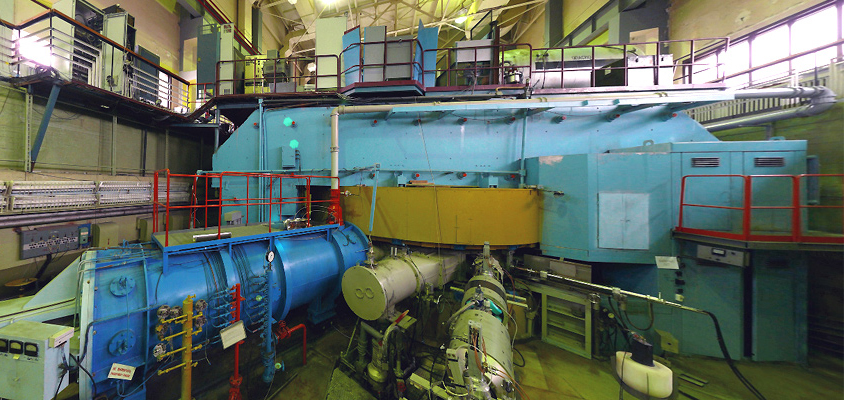JINR scientists pioneered synthesising new, neutron-deficient isotope
Media, 11 January 2023
In 2019 – 2021, a team of scientists of the Flerov Laboratory of Nuclear Reactions JINR was studying the radioactive decay properties of neutron-deficient nuclei of nobelium and rutherfordium. Based on the results of the experiments, scientists synthesised a new, neutron-deficient isotope 249No. JINR scientists were the first to synthesise this isotope, what is more, they did it with high event statistics (220 events). In addition, scientists discovered a new decay modes and isomeric states of the 253Rf isotope, analysed the α-, γ-spectra of the 256No, 257Rf nuclei, as well as obtained previously unknown isomeric states of these nuclei, and studied properties of spontaneous fissions of 252,254No and 254Rf isotopes. The obtained results help scientists to advance in understanding the properties and limits of stability of nuclear matter.
Alexander Svirikhin, Head of Sector No. 2 of the Flerov Laboratory of Nuclear Reactions JINR, commented on the results of the experiments.
249No and 253Rf
“Our team studies the radioactive decay properties of heavy nuclei mainly from the transfermium region. This study is important for understanding what the minimum and maximum ratio of neutrons and protons in the nucleus can be, what the smallest number of neutrons allows the nucleus to remain stable. For example, in one of our experiments we obtained the nobelium (No) nucleus with the mass of 249. It is the lightest isotope of nobelium discovered by us,” Alexander Svirikhin explained. The nuclei of this isotope were quite difficult to obtain: at the high-intensity beams of the U-400 Сyclotron, using the SHELS separator of the products of complete fusion reactions, scientists recorded only several dozen events of the production of 249No that allowed them to establish the scheme of its α-decay into already known nuclei. “Fermium-245, in which it decays, has been poorly studied. We discovered a decay mode associated with electron capture for it. Thus, it is capable of decaying not only by alpha decay into californium-241, as previously considered, but also into einsteinium-245, just through electron capture”, he said. In the next experiment, the 253Rf “mother” nucleus was synthesised, for which the decay into nobelium-249 was recorded, therefore confirming the “right to life” of this isotope.
Gamma-ray spectroscopy of No and Rf nuclei
Other research of the cycle is related to the gamma decay and the structure of nuclei. According to Alexander Svirikhin, one of the most accurate ways to study the nuclear forces that hold neutrons and protons together in the atomic nucleus is alpha and gamma spectroscopy. Thanks to it, it is possible to study the fine structure of alpha decay, states in which the nucleus emits gamma quanta, as well as nuclear isomers.
“Fine precision spectrometry of nuclear gamma decay, analysis of gamma quanta, is one of the powerful techniques that allows obtaining data on the structure of nuclei. Studying the excited states of the nucleus, we reach the conclusion on how neutrons and protons are grouped inside the nucleus, how this affects its stability, and the state of nuclear matter in general,” the scientist commented. Thus, FLNR researchers study fundamental properties of nuclear forces, as their properties are not fully revealed.
Spontaneous fission
One of the types of the heavy nuclei decay is the so-called spontaneous fission, during which the nucleus naturally splits into two random fragments that differ in mass. Unlike alpha decay, when the nucleus emits an alpha particle, it produces two fragments formed inside the nucleus.
“The data that generalises the properties of this type of decay is quite insufficient for nuclei heavier than fermium. There is very little data on what kind of fragments are produced, what kind of decay energy they have. Since we have the opportunity to produce a significant number of heavy element nuclei, we can study the spontaneous fission process, among others, in as much detail as possible,” Alexander Svirikhin noted.
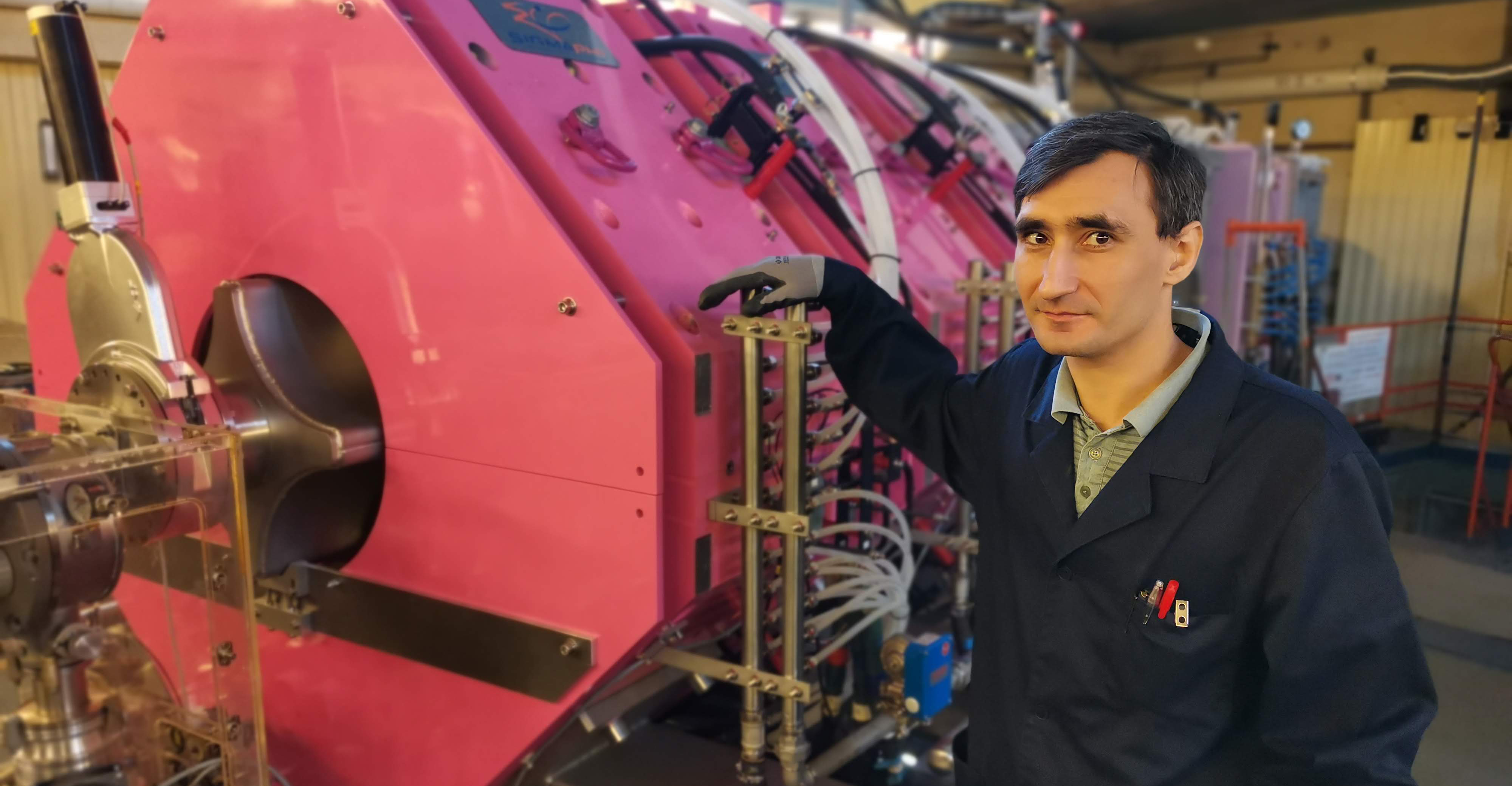 Employee of FLNR JINR Sector No. 2 Yuri Popov launching SHELS separator after modernisation
Employee of FLNR JINR Sector No. 2 Yuri Popov launching SHELS separator after modernisation
FLNR scientists evaluate such parameters of spontaneous fission as half–life, the total kinetic energy of fragments released during fission, and also measure a parameter that is not studied in any other laboratory in the world, i.e. the neutron characteristics of spontaneous fission. In the process of nuclear fission, it emits several unrelated neutrons, which leave fission fragments. This process explains the existence of a chain reaction in nuclear reactors. In their turn, scientists at FLNR JINR try to reach the conclusion about the production process of fragments by counting the number of such free neutrons.
“In fact, this is also a way to understand how nuclear forces are arranged, under the influence of which patterns fragments are produced before the nucleus decay,” the speaker continued. “There is a nucleus, it is stable, it lives for maybe seconds or maybe several millennia. Suddenly, it randomly splits into two fragments. Why exactly into these two fragments? Why is the range of their masses exactly like this? Studying all this, we get detailed and very important information about the nature of nuclear forces. Our contribution to fission physics is that we study spontaneous fission in this heavy region for nuclei heavier than fermium, for short-lived neutron-deficient nuclei.”
Alexander Svirikhin added that the SHELS separator, which was used to conduct all the experiments mentioned above, allows studying nuclei with a half-life of several microseconds. “For example, we can obtain several thousand 250No nuclei, each of which has a half-life of 4-5 microseconds. Moreover, we can study it in greater detail,” he said.
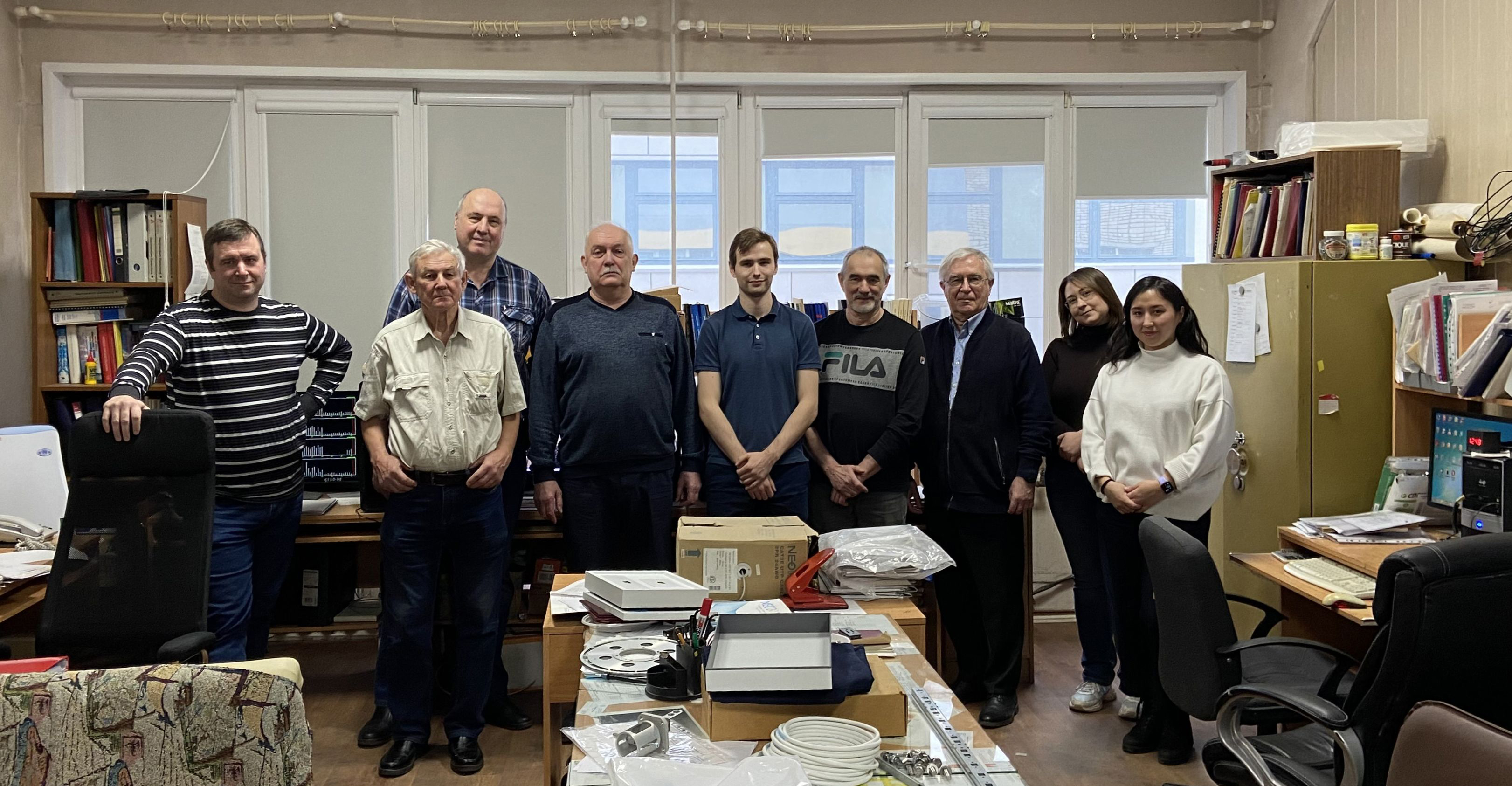 From left to right: employees of FLNR JINR Sector No. 2 Alexander Svirikhin, Victor Chepigin, Oleg Malyshev, Alexander Eremin, Roman Mukhin, Evgeny Sokol, Andrey Popeko, Alyona Kuznetsova, Mereigul Tezekbayeva
From left to right: employees of FLNR JINR Sector No. 2 Alexander Svirikhin, Victor Chepigin, Oleg Malyshev, Alexander Eremin, Roman Mukhin, Evgeny Sokol, Andrey Popeko, Alyona Kuznetsova, Mereigul Tezekbayeva
The cycle of experiments was carried out by a team of scientists of FLNR JINR: Alexander Svirikhin, Alexander Eremin, Andrey Popeko, Oleg Malyshev, Yuri Popov, Andrey Isaev, Mereigul Tezekbayeva, Roman Mukhin – together with researchers of IJCLab, IN2P3-CNRS, the Université Paris-Saclay: A. Lopez-Martens and K. Hoshild. The authors received the second JINR Prize in the section “For research experimental work”.
The details of the study were presented by the scientists themselves.
α-, γ-spectroscopy and decay properties of 249,252,254,256No and 253,254,257Rf
In recent years, with the development of heavy ion physics experimental methods, the region of nuclei heavier than fermium (Z = 100) has become available for the detailed study. The radioactive decay characteristics of heavy and superheavy nuclei obtained at the U-400 cyclotron high-intensity beams of multi-charged ions, give a picture of the nuclear matter stability and its properties. Recently, our group with the use of the SHELS separator [1,2] (Fig.1) and a wide range of detection setups has made significant progress in the study of the decay properties of the nuclei from this area.
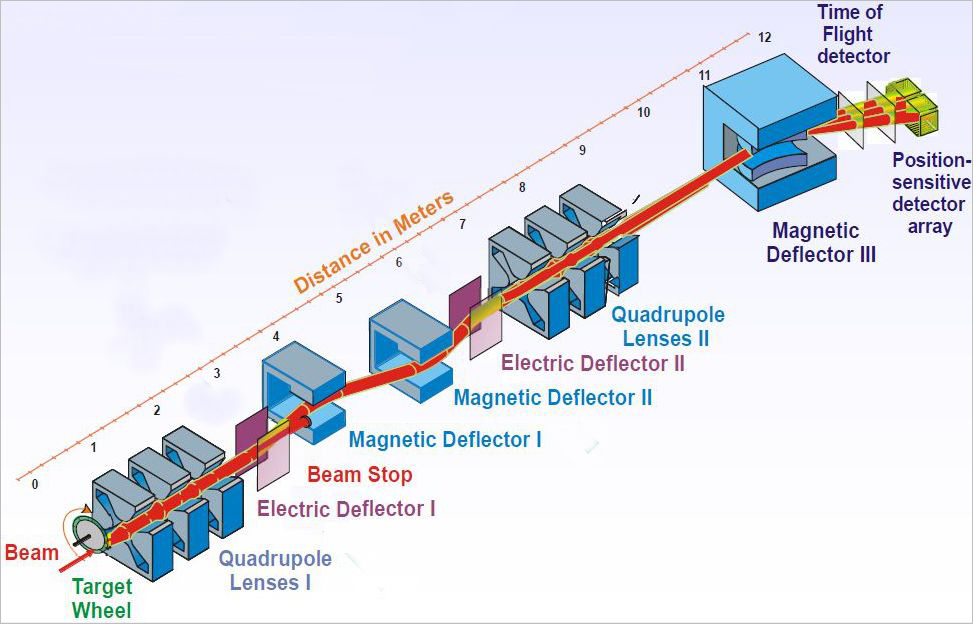 Fig. 1. SHELS – electro-magnetic separator of complete fusion reaction with heavy ions products
Fig. 1. SHELS – electro-magnetic separator of complete fusion reaction with heavy ions products
In the cycle of experiments, we studied the properties of the neutron-deficient isotopes of nobelium (No) and rutherfordium (Rf) radioactive decay, which masses placed in the vicinity of the deformed neutron shell N = 152
For the neutron-deficient 249No isotope, first synthesised in the SHELS separator experiment in 2020 [3], the half-life (T1/2 = 38,1±2,5 ms), energy of α-decay (Eα = 9129 keV) were measured. The branching ratio (bSF ≤ 0,23%) for spontaneous fission was estimated. The radioactive decay properties of 249No are shown in the Fig.2.
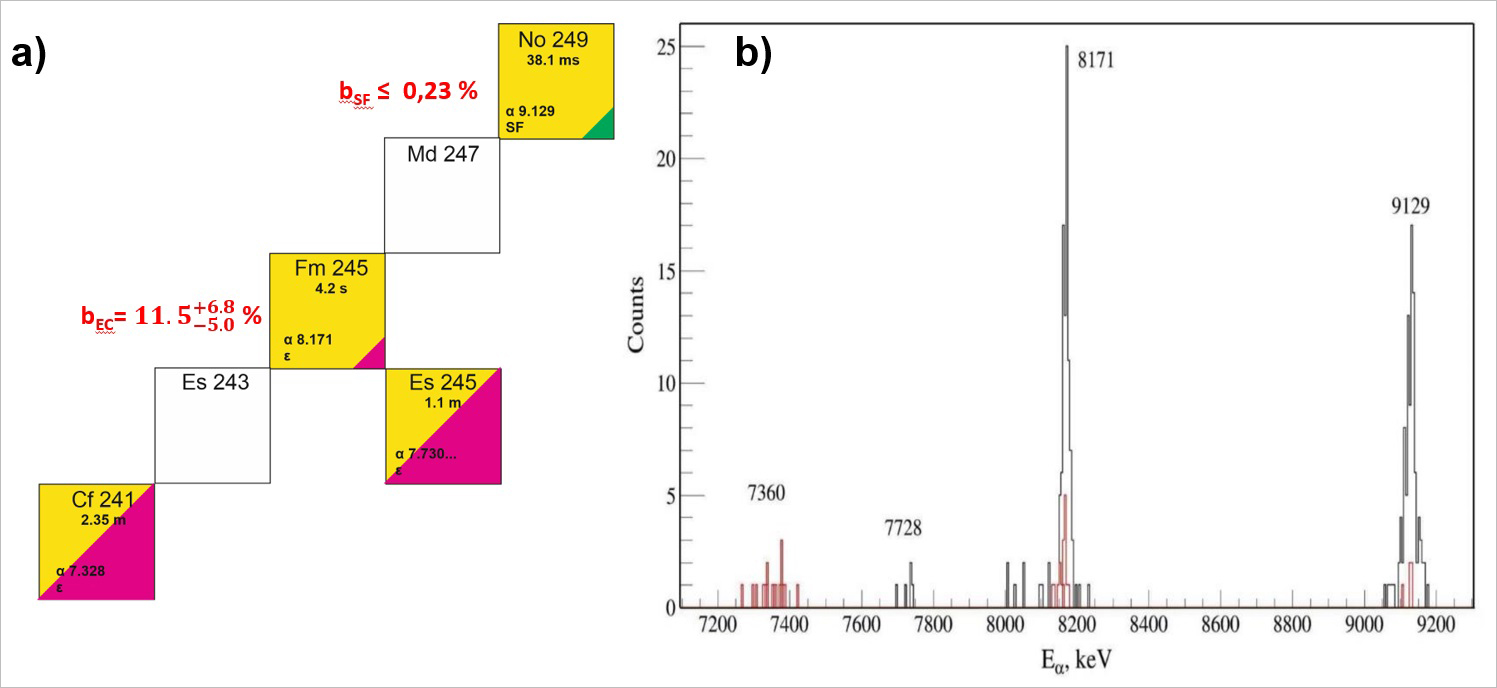 Fig. 2. a) – The 249No isotope measured decay chain, b) – Energy spectrum of alpha particles obtained from the genetic correlation analysis of the 249No alpha decay into known 245Fm (8171 keV) and 241Cf (7360 keV). The alpha activity with energy 7728 keV corresponds to the decay of 245Es obtained from β(EC)-decay of 245Fm
Fig. 2. a) – The 249No isotope measured decay chain, b) – Energy spectrum of alpha particles obtained from the genetic correlation analysis of the 249No alpha decay into known 245Fm (8171 keV) and 241Cf (7360 keV). The alpha activity with energy 7728 keV corresponds to the decay of 245Es obtained from β(EC)-decay of 245Fm
For 252,254No [4] and 254Rf [5], the characteristics of spontaneous fission, such as TKE and the yields of prompt neutrons, were studied. For 254No and 254Rf, the average number of neutrons per spontaneous fission was determined for the first time, it was 4.88 ± 0.53 and 3.87 ± 0.34 respectively. Using the improved statistical regularization method [6], the multiplicity distributions of prompt neutrons of spontaneous fission were recovered. For the short-lived isotope 252No, neutron yields were measured with record accuracy [7] at the new SFiNX detection system. The results of the measurements and the comparison with the theoretical calculations are given in Table 1.
Table 1. Comparison of measured and estimated yields of prompt neutrons of spontaneous fission of nuclei registered in the focal plane of the SHELS separator
| Isotope | Estimated average number of neutrons per fission1 | Measured average number of neutrons per fission | Multiplicity distribution variance 2 |
| 254Rf | 4.7 | 3.87±0.34 | 3.4 |
| 254No | 4.6 | 4.88±0.53 | 2.0 |
| 252No | 4.3 | 4.25±0.09 | 2.2 |
| 248Cm | 3.1 | 3.13±0.01 | 1.2 |
1) Calculation with the advanced “scission point model” A.V. Andreev, Eur. Phys. J. A 30, (2006) Andreev, Eur. Phys. J. A 30, (2006).
2) The variances were calculated using the statistical regularization method described in work [6].
For the heavier nobelium and rutherfordium isotopes the nuclear levels were studied with the GABRIELA [8] detection system for both ground and isomeric states. For the 256No nuclei a short-lived high-K isomeric state was observed for the first time [9]. It was firmly established to be a one-quasi-neutron state based on the (11/2-[725]). It is possible to see a decrease in the excitation energy of this state with an increase in the atomic number of N=153 isotones. For example, when studying the fine structure of the α-decay of 257Rf [10], scientists detected the similar state at 750 keV above the ground state.
Finally, the study of 253Rf in March 2021 confirmed the existence of two low-lying fissioning states with very different spontaneous fission half-lives (Fig. 3).
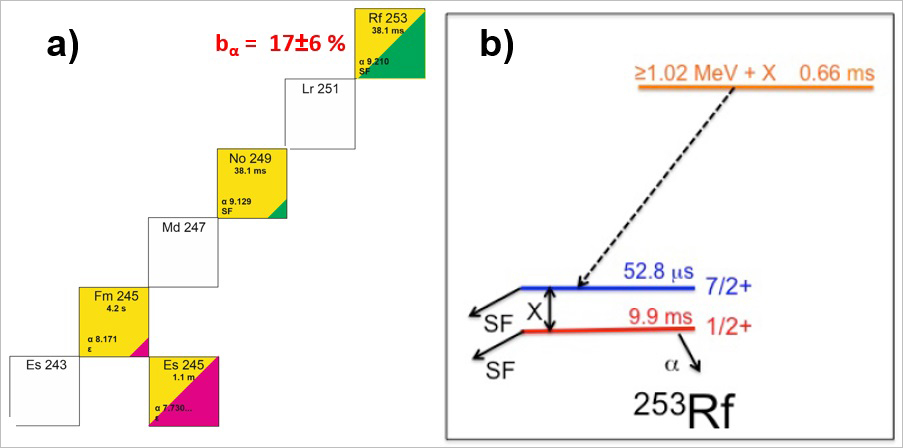 Fig. 3. a) the α-decay chain of 253Rf, b) the proposed level scheme of 253Rf isotope
Fig. 3. a) the α-decay chain of 253Rf, b) the proposed level scheme of 253Rf isotope
The observation of the internal decay of the 3rd high-K isomeric state at more than 1 MeV excitation energy has allowed scientists to determine that the shorter-lived fission activity of 253Rf corresponds to the 7/2+[624] neutron single-particle configuration. In addition, the α-decay of this isotope was first registered (bα=17±6 %), resulting in the formation of the previously obtained isotope 249No [3], the decay chain is presented on Fig. 3(a).
Our results enhance the understanding of nuclear matter behaviour in the region of neutron-deficient transfermium nuclei. Measurements of partial half-lives, decay energy, and the study of heavy nuclei isomerism extend the basis of the experimental data for the development nuclear structure models and allow estimating the boundaries of the existence of nuclei. Although, the experiments in this region are considerably limited by the low cross-section of complete fusion reactions, the techniques implemented on the SHELS separator allow synthesising the heaviest nuclei in quantities, sufficient for a detailed determination of the radioactive decay characteristics.
The results are presented in the following publications:
- Yeremin A.V., Popeko A.G., Malyshev O.N., Isaev A.V., Kuznetsova A.A., Popov Yu.A., Svirikhin A.I., Sokol E.A., Tezekbayeva M.S., Chelnokov M.L., Chepigin V.I., Lopez-Martens A., Hauschild K., Dorvaux O., Gall B., Piot J., Antalic S., Mosat P., Tonev D., Stefanova E. “Spectroscopy of the Isotopes of Transfermium Elements in Dubna: Current Status and Prospects”, 2020, Physics of Atomic Nuclei, 83 (4), pp. 503-512.
- Chelnokov M., Kuznetsova A., Dorvaux O., Gall B., Asfari Z., Tezekbaeva M., Piot J., Antalic S. “Velocity filter SHELS: Performance and experimental results”, 2020, Nuclear Instruments and Methods in Physics Research, Section B: Beam Interactions with Materials and Atoms, 463, pp. 219-220.
- Svirikhin A.I., Yeremin A.V., Zamyatin N.I., Izosimov I.N., Isaev A.V., Kuznetsova A.A., Malyshev O.N., Mukhin R.S., Popeko A.G., Popov Y.A., Sokol E.A., Sailaubekov B., Tezekbayeva M.S., Chelnokov M.L., Chepigin V.I., Andel B., Antalic S., Bronis A., Mosat P., Gall B., Dorvaux O., Lopez-Martens A., Hauschild K. “The New 249No Isotope”, 2021, Physics of Particles and Nuclei Letters, 18 (4), pp. 445-448.
- Isaev A.V., Andreev A.V., Chelnokov M.L., Chepigin V.I., Izosimov I.N., Kuznetsova A.A., Malyshev O.N., Mukhin R.S., Popeko A.G., Popov Yu.A., Shneidman T.M., Sokol E.A., Svirikhin A.I., Tezekbayeva M.S., Yeremin A.V., Zamyatin N.I., Brionnet P., Dorvaux O., Gall B., Kessaci K., Sellam A., Hauschild K., Lopez-Martens A., Antalic S., Mosat P. “Comparative Study of Spontaneous-Fission Characteristics of 252No and 254No Isotopes”, 2021, Physics of Particles and Nuclei Letters, 18 (4), pp. 449-456.
- Svirikhin A.I., Andreev A.V., Yeremin A.V., Zamyatin N.I., Izosimov I.N., Isaev A.V., Kuznetsov A.N., Kuznetsova A.A., Malyshev O.N., Popeko A.G., Popov Y.A., Sokol E.A., Tezekbayeva M.S., Chelnokov M.L., Chepigin V.I., Schneidman T.M., Andel B., Antalic S., Bronis A., Mosat P., Gall B., Dorvaux O., Retailleau B.M., Hauschild K., Lopez-Martenz A., Chauveau P., Stefanova E., Tonev D. “Prompt Neutrons from Spontaneous 254Rf Fission”, 2019, Physics of Particles and Nuclei Letters, 16 (6), pp. 768-771.
- Mukhin R.S., Dushin V.N., Eremin A.V., Izosimov I.N., Isaev A.V., Svirikhin A.I. “Reconstruction of Spontaneous Fission Neutron Multiplicity Distribution Spectra by the Statistical Regularization Method”, 2021, Physics of Particles and Nuclei Letters, 18 (4), pp. 439-444.
- Isaev A.V., Yeremin A.V., Zamyatin N.I., Izosimov I.N., Kuznetsova A.A., Malyshev O.N., Mukhin R.S., Popeko A.G., Popov Yu.A., Sailaubekov B., Svirikhin A.I., Sokol E.A., Tezekbayeva M.S., Testov D.A., Chelnokov M.L., Chepigin V.I., Antalic S., Mosat P., Brionnet P., Gall B., Dorvaux O., Kessaci K., Sellam A., Lopez-Martens A., Hauschild K. “Study of spontaneous fission using the SFiNX system” to be published in Acta Physica Polonica B Proceedings Supplement, 14 (4), 2021.
- Chakma R., Hauschild K., Lopez-Martens A., Yeremin A.V., Malyshev O.N., Popeko A.G., Popov Yu.A., Svirikhin A.I., Chepigin V.I., Dorvaux O., Gall B., Kessaci K. “Gamma and conversion electron spectroscopy using GABRIELA”, 2020, European Physical Journal A, 56 (10), art. no. 245.
- Kessaci K., Gall B.J.P., Dorvaux O., Lopez-Martens A., Chakma R., Hauschild K., Chelnokov M.L., Chepigin V.I., Forge M., Isaev A.V., Izosimov I.N., Katrasev D.E., Kuznetsova A.A., Malyshev O.N., Mukhin R., Piot J., Popeko A.G., Popov Yu.A., Sokol E.A., Svirikhin A.I., Tezekbayev, M.S., Yeremin, A.V., “Evidence of high-k isomerism in 256No”, 2021, Physical Review C, 104 (4), art. no. 044609.
- Hauschild, K., Lopez-Martens, A., Chakma, R., Dorvaux, O., Gall, B.J.P., Chelnokov, M.L., Chepigin, V.I., Isaev, A.V., Izosimov, I.N., Katrasev, D.E., Kuznetsova, A.A., Malyshev, O.N., Popeko, A.G., Popov, Yu.A., Sokol, E.N., Svirikhin, A.I., Tezekbayeva, M., Yeremin, A.V., Ackermann D., Piot J., Mosat P., Andel B. “Alpha-decay spectroscopy of 257Rf”, submitted to Eur. Phys. J. A (July 2021).
- Lopez-Martens A., Hauschild K., Svirikhin A.I., Asfari Z., Chelnokov M.L., Chepigin V.I., Dorvaux O., Forge M., Gall B.J.P., Isaev A.V., Izosimov I.N., Kessaci K., Kuznetsova A.A., Malyshev O.N., Mukhin R.S., Popeko A.G., Popov Yu.A., Sailaubekov B., Sokol E.A., Tezekbayeva M.S., Yeremin A.V. “On the fission properties of 253Rf and the stability of neutron-deficient Rf isotopes” submitted to Phys. Rev. C (Lett). (October 2021).
